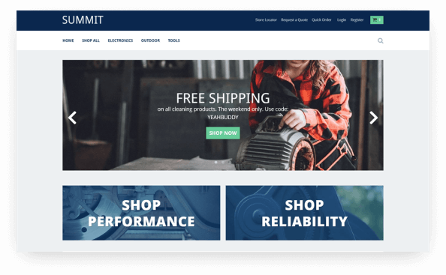Seeing an online shopping cart fill up with potential purchases is thrilling for any ecommerce business, the digital equivalent of watching a customer wander through a store’s aisles, eagerly piling item after item into a cart. Each product added to an online cart brings the business a step closer to converting a browser into a buyer—and provides a new opportunity to boost the bottom line. But all too often, that excitement quickly fades when a shopper suddenly stops clicking and disappears. The cart, still brimming with left-behind items, gets abruptly abandoned, the hope of boosting revenue slips away, and the business owner is left feeling that all the marketing, nurturing, and other efforts the company put into cultivating that potential purchase somehow fell short. The business has been ghosted without explanation—an enormous letdown.
Cart abandonment is frustratingly common, with more than half of customers who add items to carts leaving products behind without completing the purchase, leading to multibillion-dollar losses in sales revenue each year for ecommerce retailers. While some of those browsers are undoubtedly window-shopping with no intention of committing to a purchase, businesses can take steps to sway others to buy the products they’ve been eyeing. This article delves into the common causes of shopping cart abandonment and the significant impact this behavior has on businesses. Better yet, it provides tips for reducing cart abandonment and closing more sales.
What Is Cart Abandonment?
Cart abandonment occurs when a customer adds items to an online shopping cart but fails to complete a purchase. It’s a common behavior in ecommerce, one that can happen at any stage of the shopping process prior to finalizing payment.
The cart abandonment rate, which is calculated by dividing the total number of completed transactions by the total number of initiated transactions, is a critical metric for ecommerce businesses. Though it’s disappointing to watch potential customers walk away, keeping track of cart abandonment data offers important insights into customer behavior and reveals potential friction points in the shopping experience.
Customers may abandon their shopping carts for a variety of reasons. They might be turned off by high shipping costs or an unwieldy checkout process, for example, or they might simply become distracted or have second thoughts about making a purchase. Online retailers can use data from abandoned carts to optimize their websites, simplify the checkout process, and retarget customers with reminder emails or special offers to encourage them to complete purchases.
Key Takeaways
- Businesses should analyze shopping cart abandonment patterns to identify frictions in the purchasing process and develop solutions.
- With some companies providing same-day and overnight deliveries, many customers won’t tolerate lengthy delivery timelines.
- When customers leave items behind in their shopping carts, businesses must invest in new ads, promotions, and campaigns to push for stronger sales.
- Automated order processing can help speed the checkout experience, which is key to preventing cart abandonment.
- A well-timed, personalized email to remind shoppers of products in their carts can provide the necessary nudge to finalize purchases.
Understanding Cart Abandonment
For every 10 customers who express enough interest in products to place them in their online shopping carts, seven leave websites without buying the items, according to 2023 calculations by Baymard Institute. This represents billions of dollars in missed retail sales opportunities each year for ecommerce businesses. A large portion of cart abandonments results from consumers’ online browsing habits: They tend to select items and hold them in shopping carts, then surf the web, compare prices, and explore alternative options before deciding which products to purchase. It’s important for businesses to analyze abandonment patterns to determine potential friction points for consumers. Looking into internal data, as well as customer survey results, can help online retailers understand why consumers are dropping out of the checkout process and guide the development of strategies for winning over a greater percentage of buyers to increase sales.
What Causes Cart Abandonment?
Cart abandonment is often the result of several hurdles shoppers face when they’re buying online, including high shipping costs, time-consuming checkout processes, lengthy delivery times, and strict return policies—any of which can cause frustration and discourage purchases. Here’s a look at the 10 most common reasons consumers abandon their carts.
- They’re just browsing: Among online shoppers in the United States, 48% say they abandoned their cart because they were “just browsing” or were “not ready to buy,” Baymard Institute found during a 2024 study. Many of these shoppers are plunking items into carts while they’re also comparing prices and showing the same interest in similar products on other websites. Still others are just window-shopping and creating future wish lists with no intention of buying anything, while some are waiting to hand over their credit card information until they’ve found the perfect product at the right price.
- Unexpected extra costs: Setting that “just browsing” segment aside, 48% of the rest of customers who abandoned their carts did so because the extra costs of shipping, taxes, and other fees were too high, Baymard Institute found. Indeed, consumers have become increasingly cautious about their spending in recent years, particularly since the prices of consumer goods have surged by 30% between 2020 and 2024, according to PwC. In fact, a top-five reason adults in the United States, United Kingdom, and Australia try a new brand online is because it’s “cheaper than buying from other brands,” a 2024 Forrester survey shows. Bottom line: Any extra costs from shipping or other fees can dissuade customers from making a purchase.
- Mandatory account creation: Many retailers require users to create accounts before they can make purchases, partly in an effort to collect customer data. Yet this serves as a significant deterrent for many consumers. Baymard Institute found that 26% of shoppers abandoned carts because the ecommerce site required them to create an account.
- Security concerns: Given the security breaches that have impacted companies large and small, consumers may lack trust in how websites handle their credit card information and whether they’re keeping the data safe. One 2024 survey found that 97% of consumers are apprehensive about shopping on unfamiliar sites. And when asked about their biggest concern while shopping online, 24% say they’re most worried about their credit card information getting stolen. In addition, the survey results show that questions about a company’s legitimacy is the top reason consumers abandoned their carts (46%), followed by worries about credit card information (41%).
- Lengthy delivery times: With more and more companies providing same-day and overnight deliveries, consumers have come to expect near-instant gratification when they shop. This makes even minor shipping delays a major pain point. A 2023 Digital Commerce 360 survey revealed just how much shipping dates matter, with 29% of shoppers abandoning an order because it wouldn’t arrive in time, 20% ditching a site because the delivery would be too slow, and 12% leaving because the delivery date was unclear.
- Complicated or lengthy checkout process: Requiring customers to fill out excessive forms or navigate a confusing or redundant checkout process can create impatience, leading frustrated consumers to give up. In fact, Forter’s 2024 Trust Premium Report found that 31% of consumers have abandoned shopping carts due to complicated checkout processes.
- Limited payment options: Consumers expect flexible and convenient payment methods when shopping online. If the company doesn’t support digital wallets, such as PayPal or Apple Pay, offers limited credit card options, or fails to include buy-now-pay-later services, shoppers may get frustrated and drop off.
- Slow website or other technical issues: Technical glitches are a huge turnoff for customers. If a website takes too long to load or, even worse, crashes in the middle of an order, shoppers may get impatient and lose trust in the company, deciding to take their business to another site that can process their transactions without incident.
- Lack of discount codes or promotions: Nothing grabs a shopper’s eye like a sale. In fact, consumers regularly identify items they want to purchase, then search for discount codes or other promotions they can apply. If they spot a promo code, try to use it, and it doesn’t work, disappointed customers may be tempted to walk away. Or, if companies don’t offer any discounts, shoppers may decide it’s time to look for less-expensive options elsewhere.
- Unclear return or refund policies: Let’s face it: Shopping online comes with some level of risk. Will a consumer choose the right size jeans? Will a set of pots and pans perform as well in person as they appear to do online? When people are spending their hard-earned money, they want to know that they can return a product and receive a refund if it doesn’t meet their expectations. Many shoppers will steer clear of websites with unclear or unforgiving return policies that charge high fees to ship an item back.
What Is the Average Shopping Cart Abandonment Rate?
The average shopping cart abandonment rate is a whopping 70%, according to Baymard Institute. The rate of abandonment varies, depending on the region, industry, and even the device a shopper uses. For example, in February 2025, the shopping cart abandonment rate was highest for the luxury and jewelry segment at nearly 83%, while pet care and veterinary services saw the lowest abandonment rate at about 54%, according to Dynamic Yield. In terms of regions, Asia Pacific experienced the most abandoned carts at 80%, followed by Europe, Middle East, and Africa at nearly 77%, and the Americas at 71%. Meanwhile, mobile has the highest rate of shopping cart abandonment among all devices at almost 78%, followed by tablets at 69% and desktops at 67%.
Effects of Shopping Cart Abandonment on Businesses
When customers leave their shopping carts without making a purchase, those losses in sales may directly impact a company’s revenue, inventory holding expenses, and cash flow. Ultimately, if competitors are better at enticing customers to complete purchases, companies with high abandonment rates could lose their competitive edge, leading them to dedicate more resources toward acquiring customers. The most significant impacts of cart abandonment include:
- Lost sales and revenue: Cart abandonment can result in lost sales and lead to decreased annual revenue for businesses. This loss not only immediately impacts companies but can also affect long-term profitability, as businesses struggle to identify new customers and recover those who’ve disappeared.
- Increased customer acquisition costs: When abandonment rates are high, businesses must invest more in attracting new customers. This means companies may need to ramp up their marketing efforts, often spending more on ads and promotions to draw traffic and recapture buyers. As cart abandonment rates rise, the cost of acquiring customers effectively increases.
- Reduced conversion rates: Cart abandonment inevitably leads to a drop in conversion rates. Lower conversion rates can be a sign that a business has issues in the sales funnel and may need to dedicate more resources to attracting and retaining customers.
- Higher inventory holding costs: Abandoned carts can increase inventory holding costs, since businesses must pay to store and insure unsold inventory. Also, items that are placed in shopping carts are often temporarily removed from inventory shelves, so when carts are abandoned, businesses may struggle to manage inaccurate inventory levels, which can become a particular problem if a business has limited stock or sells time-sensitive products.
- Wasted marketing spend: Business leaders may determine that the investments they’ve made in marketing their products have been wasted if visitors are abandoning their carts. This may lead companies to invest in new ads, promotions, and campaigns to push for better sales figures. This inefficiency can strain marketing budgets and reduce overall return on investment.
- Lower customer lifetime value: Customers who abandon their carts may be less likely to return for future purchases, significantly impacting the customer lifetime value and forcing the company to rely on continually acquiring new customers.
- Negative impact on cash flow: Businesses can experience inconsistent cash flow as a result of abandoned carts, making it more challenging for them to meet operational costs, pay suppliers, and fulfill customer orders.
- Missed opportunities for customer engagement: When a customer disappears, the business has missed an opportunity to engage with that shopper, build a relationship, and perhaps benefit from cross-selling and upselling. And missing those opportunities could mean losing the chance to turn a one-time visitor into a loyal, long-term customer.
- Reduced competitive advantage: Online retailers with higher abandonment rates often find themselves falling behind competitors that have taken steps to successfully minimize cart abandonment. This translates into a loss of market share and potential damage to the company’s reputation.
- Need for additional retargeting efforts: To recover lost sales, businesses often need to invest in retargeting strategies, such as ads, email campaigns, and personalized offers. Although these efforts can be effective, they require additional resources, further increasing the overall cost of customer acquisition.
How to Reduce Cart Abandonment and Close Sales: 10 Tips
While eliminating all cart abandonment may not be realistic, retailers can take steps to prevent some customers from fleeing and, as a result, close more sales. Strategies for enticing customers to finalize purchases include everything from streamlining the checkout process and building customer trust to circling back to encourage consumers to follow through. Here are some tactics that have been proven to work.
- Offer free or transparent shipping: Since shipping costs are a significant barrier to purchases, ecommerce businesses should make every attempt to offer free shipping or keep shipping fees to a minimum. And regardless of the cost, companies should make sure they’re being transparent about any shipping fees early in the checkout process so the extra costs don’t surprise customers, tempting them to jump off the site. When customers are comparing prices online, they want to be able to take shipping fees into consideration, so businesses need to let customers know up front the total cost of a purchase.
- Simplify the checkout process: With 22% of US online shoppers abandoning orders due solely to a checkout process that was too long or complicated, according to Baymard Institute, getting customers through checkout quickly and easily is critical. Baymard says an ideal checkout flow should include as few as 12 to 14 elements, yet the average US checkout flow contains 23. Simplifying the checkout form could increase ecommerce sales by 35%, and with ecommerce sales of $738 billion in the United States and European Union, that translates into $260 billion worth of lost orders recoverable solely through a better checkout design, Baymard Institute calculates. Automating order processing can also help speed the checkout process.
- Allow guest checkout: Customers can feel overwhelmed by requests to create accounts and recall passwords, so ecommerce sites should allow visitors to bypass the account creation step and check out as guests to eliminate this barrier. This simple change often provides a faster, friction-free shopping experience, leading to higher conversion rates.
- Provide multiple payment options: Offering a variety of payment methods can make a significant difference in encouraging more sales. In addition to accepting credit and debit cards and digital wallets, online retailers should offer buy now, pay later services, such as Klarna or Afterpay, to accommodate the needs of more customers and convince them to move forward with transactions.
- Optimize website speed and mobile experience: If a site takes longer than a few seconds to load, shoppers may lose patience and move on. The same goes for a poor mobile experience—today’s consumers don’t want to take the time to figure out how to navigate a slow or glitchy site. To reduce abandonment, websites should be optimized for both speed and mobile use. Retailers should embrace the latest technology tools to assist with a smooth online experience, including using responsive design, compressing images to allow for faster loading, and leveraging caching to provide a smooth experience for customers on any device.
- Display trust signals: Customers are more likely to complete a purchase if they feel secure about trusting a business to protect their credit card data and other personal information. Displaying trust signals, such as security badges and customer reviews, can help build people’s confidence in the company’s ability to protect payment information, often leading to higher conversion rates.
- Offer discounts or promo codes: People want to know they’re getting a good deal, and nothing spurs a purchase like a good coupon. In a 2024 Statista survey, 40% of online shoppers in the United States say they desire anywhere from 10% to 20% off their entire shopping carts, and another 33% want between 20% and 30% off their purchases. To incentivize customers to finalize their purchases, businesses should offer time-sensitive discounts, free gifts, and exclusive deals for loyal customers. Promo codes not only increase purchases, but they can also create a sense of urgency, prompting customers to act quickly so they don’t miss out.
- Send cart abandonment reminders: A well-timed, personalized email or text to remind shoppers of the products they’re missing out on can reengage customers and provide just the nudge they need to complete their purchases. In fact, a 2025 Moosend survey found that 40% of emails sent to those who had abandoned their carts were opened, half were acted on (meaning, a customer clicked on a link or call to action inside the email), and half of the customers who clicked ended up completing their purchases.
- Provide clear return and refund policies: When a return policy is unclear or includes too many restrictions, buyers can hesitate to pull the trigger on a purchase. In fact, a 2024 Blue Yonder survey of consumers found that 69% say tighter returns policies have deterred them from making purchases. Meanwhile, 91% said a lenient return policy influenced their decision to buy products. So, it’s important for companies to outline clear, hassle-free return and refund policies—and charge minimal to zero return fees—to build trust and ease buyers’ concerns.
- Use progress indicators during checkout: Customers want to see that they’re moving quickly through the checkout process, so providing progress indicators, such as a visual bar showing the stages of checkout, helps set expectations and reduce anxiety that a purchase might take too much of their time. When users understand how close they are to completing a purchase, they’re more likely to relax and keep going.
Close More Sales With NetSuite
Reducing cart abandonment starts with providing customers with seamless, personalized shopping experiences. NetSuite Commerce supports both B2C and B2B ecommerce with a single platform, engaging customers on multiple levels through a unified cloud solution that centralizes key data, such as item, inventory, customer, and order information. This multifaceted approach meets consumer expectations for a consistent, streamlined shopping experience, whether they’re purchasing or returning goods.
Plus, NetSuite provides businesses with a single view of their inventory across all channels and the supply chains, allowing companies to avoid stockouts and ensure efficient delivery of products to customers. Ultimately, the platform’s ability to reduce friction in the purchase process leads to fewer abandoned carts and higher conversion rates.
NetSuite Commerce

Understanding the causes of cart abandonment is important when figuring out how to take targeted actions to prevent customers from ditching the items they’re eyeing. Customers abandon carts for many reasons, including unexpected costs, complicated checkout processes, and concerns about payment security. By proactively addressing these and other issues, businesses can create a smoother, more transparent shopping experience, easing customer concerns while building trust and fostering loyalty, all of which can prevent cart abandonment. Implementing strategies, including offering free shipping, allowing guest checkout, and sending follow-up emails to remind customers about items they’ve left behind, can go a long way toward improving conversion rates and increasing customer satisfaction. In addition, leveraging technology solutions to streamline order management and improve inventory visibility can further reduce frictions in the purchasing process and boost sales.
Cart Abandonment FAQs
What is a good cart abandonment rate?
A good shopping cart abandonment rate is generally considered to be one that’s lower than the average rate of 70%. However, the ideal rate can vary, depending on the industry and the region consumers are shopping from. For example, industries with more expensive products, such as jewelry and other luxury items, may experience abandonment rates of 80% or more on average, so a rate below that would be considered decent.
Why is shopping cart abandonment a problem?
Shopping cart abandonment is a huge problem because it leads to the loss of potential revenue for ecommerce businesses. When customers add items to their carts but fail to finalize purchases, businesses miss out on those possible sales. In addition, high shopping cart abandonment rates can increase customer acquisition costs, since companies must invest more in retargeting campaigns and other marketing strategies to attract customers and solidify purchases.









